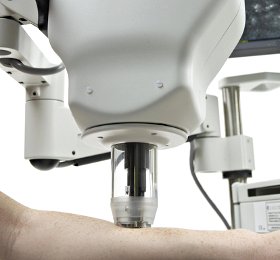Your big toe deviates towards the others? A painful lump appeared on the front side of the foot? So, you have probably hallux valgus, commonly called “bunion”.
This bone deformity, affecting one person out of fifteen, mainly women (90%) in their fifties, can be very painful and handicapping. And this on several levels.
Indeed, an bunion can not only hurt badly – walking and at rest, shod or bare foot – but it can also cause a great shame to its unfortunate “owner”. Not to mention the practical aspects. Standing up or walking for a long time can become very painful. Finding shoes that fit is often a real headache. And when one finally discovers THE pair that fits, however, the shoe will quickly lose its shape, because of the bunion.
Hallux valgus (from the latin hallux – first toe and valgus – outward) is a slowly progressive deformity of the big toe. Its deflection causes a protrusion, the bunion, around the joint, on the first metatarsal. One often makesnarrow shoes with high heels responsible for this affliction. This partly explains why women are more affected than men. But there may be other causes.
Except its congenital form, rare, affecting children, bunion is not hereditary. This being said, the angle of the big toe might already be high at birth. This distortion may or may not worsen, and cause pain, depending on how one walks and the shoes one wears.
Other anomalies can favor the deformation of the big toe. Like a too flexible ligament, flat feet or retraction of the Achilles tendon and the flexor muscles of the toes.
Additionnaly to the pain already mentioned, hallux valgus may have many consequences, including:
- bursitis with risk of infection;
- overlapping toes;
- pain under the heads of the other metatarsals, mainly the second, due to the displacement of the big toe’s load to the neighboring toes;
- calluses (horns) on the inner edge of the foot and the big toe;
- one or more claw toes (retracted), with or without calluses.
A consultation is needed as soon as pain and defomrity of the big toe appear. The sooner a specialist intervenes, the better he will be able to prevent the progression or correct the deformity before it increases. Diagnosis will be done with a frontal and profile (standing) radiography of both feet. It assesses the degree of deviation of the toe, and its impact on the skeleton of the foot.
When to operate?
There are four main reasons to operate a hallux valgus:
- pain (not relieved by painkillers or other auxiliary means);
- mental suffering;
- the frustration of not being able to freely choose one’s shoes
- prevention of degenerative disorders (osteoarthritis).
If both feet are affected, they can be operated simultaneously, depending on the extent of the deformation, the type of surgery, the patient’s age, activity and its pain threshold. The advantage: the patient will have to deal juste once with the postoperative (pain, temporary disability, incapacity for work).
The operation can be performed by open surgery or minimal invasive surgery (small incision) or percutaneously.
The percutaneous technique requires the insertion of a spindle of 2 mm of diameter. The patient can still walk, with special shoes. The spindle has to be checked every week during the month following surgery, and then is easily removed without anesthetic.
After an open or minimal invasive operation, the dressing is changed every week the stiches are removed after three weeks. The specialist controls after 6 weeks, 3, 6 and 12 months, depending on the evolution of healing.
Depending on the patient, the postoperative and recovery period can be spectacularly easy or difficult.








